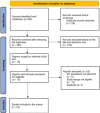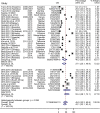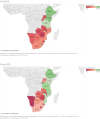Estimates of the prevalence of male circumcision in sub-Saharan Africa from 2010-2023-A systematic review and meta-analysis
- PMID: 38478528
- PMCID: PMC10936832
- DOI: 10.1371/journal.pone.0298387
Estimates of the prevalence of male circumcision in sub-Saharan Africa from 2010-2023-A systematic review and meta-analysis
Abstract
Background: Male circumcision (MC) is a key part of the package of interventions to prevent HIV, the biggest health challenge in sub-Saharan Africa.
Objective: To estimate the male circumcision prevalence and to evaluate the progress towards meeting WHO targets in sub-Saharan Africa during the period 2010-2023.
Methods: We carried out a systematic review and meta-analysis of studies published during the period 2010-2023. We searched PubMed, Scopus, Cochrane CENTRAL, Google Scholar, WHO and the Demographic and Health Survey for reports on MC prevalence in sub-Saharan Africa. MC prevalence was synthesized using inverse-variance heterogeneity models, heterogeneity using I2 statistics and publication bias using funnel plots.
Results: A total of 53 studies were included. The overall prevalence during the study period was 45.9% (95% CI 32.3-59.8), with a higher MC prevalence in Eastern (69.9%, 95%CI 49.9-86.8) compared to Southern African (33.3%, 95%CI 21.7-46.2). The overall prevalence was higher in urban (45.3%, 95%CI 27.7-63.4) compared to rural settings (42.6%, 95% 26.5-59.5). Male circumcision prevalence increased from 40.2% (95% CI 25.0-56.3) during 2010-2015 to 56.2% (95% CI 31.5-79.5) during 2016-2023. Three countries exceeded 80% MC coverage, namely, Ethiopia, Kenya and Tanzania.
Conclusion: Overall, the current MC prevalence is below 50%, with higher prevalence in Eastern African countries and substantially lower prevalence in Southern Africa. Most of the priority countries need to do more to scale up medical male circumcision programs.
Copyright: © 2024 Elsayed et al. This is an open access article distributed under the terms of the Creative Commons Attribution License, which permits unrestricted use, distribution, and reproduction in any medium, provided the original author and source are credited.
Conflict of interest statement
The authors have declared that no competing interests exist.
Figures





Similar articles
-
Mapping male circumcision for HIV prevention efforts in sub-Saharan Africa.BMC Med. 2020 Jul 7;18(1):189. doi: 10.1186/s12916-020-01635-5. BMC Med. 2020. PMID: 32631314 Free PMC article.
-
The potential impact of male circumcision on HIV in Sub-Saharan Africa.PLoS Med. 2006 Jul;3(7):e262. doi: 10.1371/journal.pmed.0030262. PLoS Med. 2006. PMID: 16822094 Free PMC article.
-
Male circumcision, religion, and infectious diseases: an ecologic analysis of 118 developing countries.BMC Infect Dis. 2006 Nov 30;6:172. doi: 10.1186/1471-2334-6-172. BMC Infect Dis. 2006. PMID: 17137513 Free PMC article.
-
Prevalence and factors associated with maternal and neonatal sepsis in sub-Saharan Africa: a systematic review and meta-analysis.Front Public Health. 2024 Jan 24;12:1272193. doi: 10.3389/fpubh.2024.1272193. eCollection 2024. Front Public Health. 2024. PMID: 38327574 Free PMC article.
-
HIV Prevalence Among Tuberculosis Patients in Sub-Saharan Africa: A Systematic Review and Meta-analysis.AIDS Behav. 2019 Jun;23(6):1561-1575. doi: 10.1007/s10461-018-02386-4. AIDS Behav. 2019. PMID: 30607755
Cited by
-
Acceptability, feasibility and appropriateness of intensified health education, SMS/phone tracing and transport reimbursement for uptake of voluntary medical male circumcision in a sexually transmitted infections clinic in Malawi: A mixed methods study.PLoS One. 2025 Jan 24;20(1):e0301952. doi: 10.1371/journal.pone.0301952. eCollection 2025. PLoS One. 2025. PMID: 39854431 Free PMC article.
-
Retrospective analysis of clinical outcomes and early complications of conventional circumcision techniques and thermocautery-assisted circumcision.Sci Rep. 2025 Feb 28;15(1):7139. doi: 10.1038/s41598-025-91730-5. Sci Rep. 2025. PMID: 40021714 Free PMC article.
References
-
- UNAIDS. Global HIV & AIDS statistics—Fact sheet. 2021. [cited 2023 4/23]; Available from: https://www.unaids.org/en/resources/fact-sheet.
-
- Organization, W.H., Global HIV Programme. 2021.
-
- Bailey R.C., et al.., Male circumcision for HIV prevention in young men in Kisumu, Kenya: a randomised controlled trial. Lancet, 2007. 369(9562): p. 643–56. - PubMed
-
- Mills E., et al.., Male circumcision for the prevention of heterosexually acquired HIV infection: a meta-analysis of randomized trials involving 11,050 men. HIV Med, 2008. 9(6): p. 332–5. doi: .1111/j.1468-1293.2008.00596.x - PubMed
-
- Weiss H.A., Quigley M.A., and Hayes R.J., Male circumcision and risk of HIV infection in sub-Saharan Africa: a systematic review and meta-analysis. Aids, 2000. 14(15): p. 2361–70. - PubMed
Publication types
MeSH terms
LinkOut - more resources
Full Text Sources
Medical

